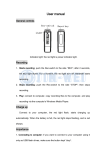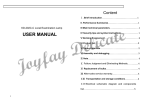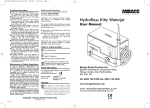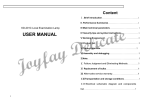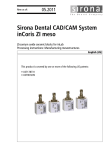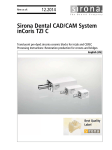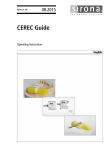Download ILLUME IMPLANTS Brochure- with extra photos
Transcript
ILLUME IMPLANTS I'D LIKE TO START WITH SOME BASIC INFORMATION PLEASE... ... These implants, what are they, exactly? They're like brand new solid teeth; they even have their own roots. How is that possible? Two very specific things make implants possible. The first is the fact that human bone bonds to titanium. The second is the discovery that it's possible to grow new bone where it's previously shrunk. So, in practice, we can put a whole new titanium root in the gum, and then build a new tooth above it. What this means : To a great many people, this means the world. They no longer have to choose between dentures (which are unstable and move around) and bridges (which rely on the reshaping of perfectly good teeth). Neither do they always have to look for the softest food on the menu or instinctively cover their mouth with their hand when then they laugh or smile. "I have had five implants due to a serious gum problem. My smile has been completely transformed. I can now smile with complete confidence and would thoroughly recommend this treatment to anyone." Mrs H.M. SAY I'M THINKING ABOUT HAVING THIS TREATMENT; I’VE GOT PLENTY OF QUESTIONS... ... For instance, why should I come to you for it? Well, for one thing, our success rate is over 90%, which is better than the industry average. Statistics are over-rated, though. It's more important that our experience of actually using implants goes back 15 years, and that to even arrive at that point, we studied under some of the field's leading practitioners, and learnt techniques from the individuals who'd actually pioneered them. What this means in practice, apart from the fact that you'll be in the care of highly experienced professionals, is that we've studied different techniques and mastered them. And from the multiple approaches at our disposal we can offer the one which works best for you (they all have their own strengths and weaknesses). So not all implants are the same then? Far from it. In fact, like products in many fields, there's a huge variety. Some of the systems available now are backed up by practically no research at all. Others are just cheaply made, and it shows. It's worth remembering, though, that this is a product to be fitted in your mouth, that's going to have to last. We use systems made by Straumann. No one else has as much, or as thorough, data and expertise to back them up. They have been doing this for 30 years; no one can match them for quality and sophistication. And how long do they last? Put it this way. The industry leader, Professor Branemark (from Gothenburg, Sweden) first fitted one of these around 40 years ago, and it's still intact. Our first one dates back 15 years and is likewise thriving. If things go wrong in dentistry, the figures show they tend to go wrong in the first year. And in that first year, the first two months or so tend to be the riskiest time. So if we can get your implants safely through their first couple of months, the chances are they'll last for a very long time. "As an older patient (80 years) I was rather worried that the implant might not take, but all was well and the implant rooted successfully." Miss S.R. THAT'S ALL FINE, BUT I HATE GOING TO THE DENTIST... ... And this sounds like A LOT of work. Doesn't it really hurt? You'd think it would hurt, yes. And let's face it; part of what we do involves drilling through bone. But, just as with a filling, you'll have a local anaesthetic. You'll probably feel a bit bruised for a couple of days, but nothing a painkiller or two won't fix. There's probably not much we can say at this stage to convince you it doesn't hurt, but it's hardly a coincidence that, when people who've previously had implants have a space that needs filling, their first choice tends to be to have another implant. What is it you'll actually do? After we make the hole, we put the titanium implant into the bone and leave it for six or eight weeks. (Think of it like a rawl plug in a wall; it allows other things to be fixed on to it.) We'll test to see if the bond between bone and titanium is complete. If it isn't, we just wait a little longer. If it is, though, the dentist takes moulds of your teeth and gums. From these we make the tooth-like top which takes two or three weeks, and then we either glue or screw that onto the implant, depending on which kind we use. I 'd quite like to be put to sleep before all that starts. Can you do that? Not completely to sleep, no. Only hospitals do that now. But we do have other options to sedate you. One is to give you some Valium; you take half the night before (and get a good night's sleep) and the other half an hour before the procedure, to make sure you're relaxed. Another way we can go is to put a small mask over your nose and have you breathe a mix of nitrous oxide (laughing gas) and oxygen. You'll feel agreeably floaty throughout the treatment. The third option is the intravenous way. A small tube carries a measured dose into a vein in the back of your hand. This guarantees you feel comfortable the whole time. "I am very nervous and was very apprehensive, but I felt no pain or discomfort and was reassured by you. You inspired every confidence in having implants and, when I lose more teeth as time goes by, I WILL BE BACK!" Mrs C.P. SEDATION SOUNDS GOOD, I'M BEGINNING TO COME ROUND TO IT, BUT... ... Don't hold back now. What can go wrong? Sometimes, though not often, there's a short-term problem with the bond between bone and implant. Remember we said we leave it six or eight weeks then check? Well, occasionally we have to leave it another six or eight weeks, because the bond's been slow to establish. Even more occasionally (in roughly 2% of cases) there's just no bond at all. In which case we start all over again, although when we do, it all happens more quickly, as the hole's already there. Human biology is never 100% predictable, and there's no rhyme or reason to this firsttime failure to bond, but in our experience there's no predisposition, either, to a second-time failure. Is that all? Not quite. There can be a longer-term problem which might be noticeable on a routine X-ray and show the bone shrinking and the implant losing support. If there's a lot of stress on the teeth (if you grind them at night, for example, or clench them) you might notice this. To help, we can fit you with an 'anti-grinder’, a plastic shield to be worn at night, if grinding your teeth is a particular problem. Or, to kind of head off the danger, we can build in an early warning system. By using a medium strength glue on the crown, if it comes under too much pressure it will fall off. At this point we can adjust the top crown before recementing it, so that in future it doesn't come under too much pressure. However, for most people, who don't unduly clench or grind their teeth, this problem won't arise. What about a gap? Won't I have a big gap in my mouth for 8 weeks? You would, yes, if we did nothing about it. But while we wait for the bond to work, to avoid that happening we can either: - glue a temporary plastic tooth to the teeth on either side; - make a plastic plate, especially useful if the gap's bigger than a single tooth; - fix a temporary tooth to the implant (which we can only do if the implant is very stable very early); or - if a crown needs to be replaced to one side or other of the gap, we can make a small bridge to fill the gap. How do they actually look? Don't they kind of stand out a mile? We can explain things in far more detail when and if you pop in for a chat about this. The short answer to this is No, they don't. The long answer - which explains why - involves an awful lot of technical information. But to sum up, and to try and keep it simple: -Lifelike crowns The key is a tooth-coloured core with a white, but light-permeable, porcelain built on. The fact that the light passes through - as it would on a natural tooth - makes for a high-quality and utterly lifelike tooth. - Anatomical articulation Not that easy to say, and fiddly and time-consuming to do, too. This is the way to make a crown that not only fits your mouth perfectly when you bite, but also when your mouth moves around in any and every direction. This is the technique that guarantees crowns which feel like they really belong in your mouth from day one. - Shade-taking Think of this as very advanced colour-matching. The technician in charge of this process needs to see, both personally and via digital photography, all the different variations in shade found on your teeth. Only this intensive, specialist and personalised service guarantees crowns which look exactly like your own teeth. "The clinical expertise was impressive, great care to match tones, size and shape of the new teeth. They are such an improvement on those they replace, I smile quite a lot! I would recommend the treatment most heartily." Mrs L.P. OK. SO YOU'VE GOT THE TECHNOLOGY SPOT ON, BUT ... ... I'd like to know about the process, the before, during and after ... Everything we do - implants, checkups, extractions, whatever it is - we do with a huge amount of care and in full and open consultation with you. Illume is about listening to you, taking time, and instilling in you a complete trust in our excellence. It's what makes us different. So, an hour before your implant appointment you take antibiotics to make sure your bloodstream's clear of any bacteria which could harm the chance of the implant bonding to the bone. Everything at the implant procedure - gowns, drapes, wipes, etc. - is sterile, and more like the conditions you'd associate with an operating theatre than a dentist's. And afterwards you'll be given a variety of rinses and antibiotics to give the bond the best possible chance to form effectively. Yes, we could give you fewer, do the whole thing more cheaply and rely a little more on chance and crossed fingers. We prefer to take the route of high-quality technology, longpractised expertise and years of research; that's how we can talk with such confidence about implants fitted by Illume. "I was impressed by the hygienic preparations, which involved masks and protective glasses for Mr Hipwell and his assistant, and I was draped with coverings from my chin to my toes." Mrs M.W. "There were full discussions and explanations before any treatment was begun ... This made me feel in control of the situation. There was no pain during the actual operation and there were analgesics to cope with soreness and discomfort after ... I don't really think about having implants in my mouth - apart from caring for them - they look and feel like my own teeth ... I've recommended others to look at implants and will continue to do so." Mrs C.A. POST OPERATIVE CARE • Feeling better • Getting back to normal • How to heal quickly • Helping you to heal Feeling better: Why have I been given this? Because after implant treatment you might feel slightly uncomfortable for a short time, and you might have some questions. You're entirely welcome, of course, to get in touch anyway, to talk to us about anything to do with your treatment. On the other hand, you might prefer to take the few minutes it takes to read this booklet; we're pretty sure we cover just about every question you could have. And one last thing: don't worry. The most frequent comment we hear from clients after implant treatment is how surprised they are that they felt - and continue to feel - so little ... The drugs do work We'll already have given you these, as well as some advice on how and when they're best used, but here's a quick recap: Ibuprofen: This reduces pain and swelling. You really only need them, though, if you notice swelling, and even then the dose is just two tablets, three times a day, for three days. Mouthwash: As you can imagine, you'll want to avoid ordinary brushing for a few days, but this helps keep the whole area clean. (10ml for a minute or two, three times a day for a week.) Even when you go back to brushing, to begin with use the toothpaste we give you; your usual brand will prevent the mouthwash working. Arnica: It's great for speeding up the healing process. (Take two, three times a day, for a week.) We'll have shown you how to take them already, just remember there's a knack; they're a homeopathic medicine, so you need not to touch them with your fingers. Getting back to normal: Afterwards: what counts as 'normal'? As with any treatment, no two individuals are ever identical, so what's 'typical' is hard to describe. But as we already said, the most common reaction we get is that the implant treatment was far less eventful than had been imagined, and subsequent healing far quicker, too. Still, it's better to be prepared, so do bear in mind a couple of things. A little bit of swelling and a bruised sensation might last a few days. A week or so is as long as you're likely to feel this, however, after which you can brush gently with the Corsodyl gel we give you at your one-week review. The other thing to remember is, don't panic if you think your implant's worked itself loose. It's not what you think: there's a cover screw over the top of the implant and, occasionally, it can loosen a little. Although it might feel worrying to you, it's fixed easily by popping in and having us re-tighten it. How to heal quickly: Life's pleasures: what about eating, drinking and smoking? As far as eating goes, just try and use the other side of your mouth as much as you can for the first fortnight or so, especially if you've had a temporary crown fitted. The problem with alcohol is that once it's inside you, your body straight away devotes all its energies into cleaning it out of your bloodstream. For the first couple of weeks after the treatment, your body's energy would be put to much better use making sure the implant bonds properly. So our advice would be to do yourself a favour and leave it completely for that first fortnight. Much the same goes for smoking. The reason it can make your fingertips go white is the same reason it's a bad idea at this point; it stops your blood circulating properly, especially to your peripheries. And the one thing you need now is a really good blood supply; it's what helps the bone at the implant site repair quickly. Try your hardest to stop completely, and if you can't, then do cut down as much as you can, for a week before as well as a fortnight after. The implant's such a major investment, you might as well do all you can to make it work. Helping you to heal: Care and maintenance: the bit that sounds like a user's manual Think of this as a refresher, nothing here should be new to you, as we'll have gone through it with you in person. (Generally, don't be concerned if you notice bleeding, at least for the first week. If it's still happening after that, then do get in touch ... ) Ordinary brushing The watchword here is 'gently'; apply that to this advice and you won't go far wrong. Concentrate on where your gum meets the top of the implant, this is the bit that needs looking after most. The bristles should be half on the gum and half on the implant crown; just rock the brush backwards and forwards. The middle bristles are the ones we want to do the work here, and the work is cleaning the junction between crown and gum. Extraordinary brushing By which we mean using a 'bottle brush' to clean in between (or, if you prefer, interdentally). It's not so different from using the ordinary brush. You need the same backwards-and-forwards motion, the right size of brush (which we'll have already shown you) and to position the brush properly, ie, at gum level, between the implant and the next tooth along. (Do make sure any replacements you buy are the right size, too ... ) Using a woodstick You might need one of these if a bottlebrush won't fit in the gap between your teeth. We'll definitely show you how best to use one, as any description can't help but make it sound harder than it really is, but the thing to remember is to rub the woodstick's thin, flat side against the gum. Mouthwash Other than the period following treatment, we don't really recommend you use mouthwash. The techniques we talk about above should be all you need to guarantee good gum health. Take care, take our advice and don't forget: if anything's bothering you at all, get in touch and ask us about it. And don't worry that it might be too small to ask us about, it's our job ... ILLUME address. 3a Queens Road, Cheltenham, Gloucestershire, GL50 2LR ph. 01242 522230 em. [email protected] wb. www.illumedentistry.co.uk




























